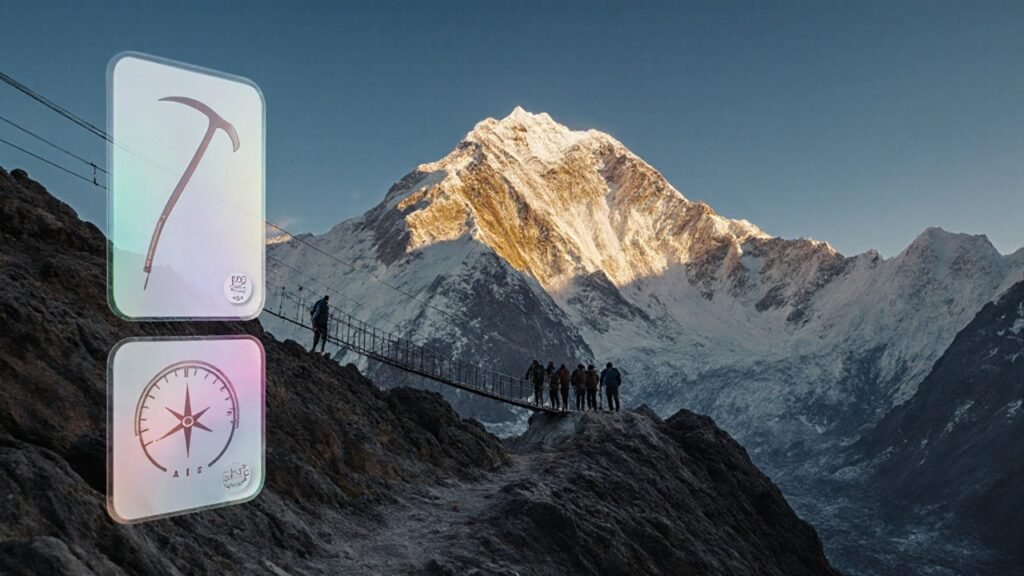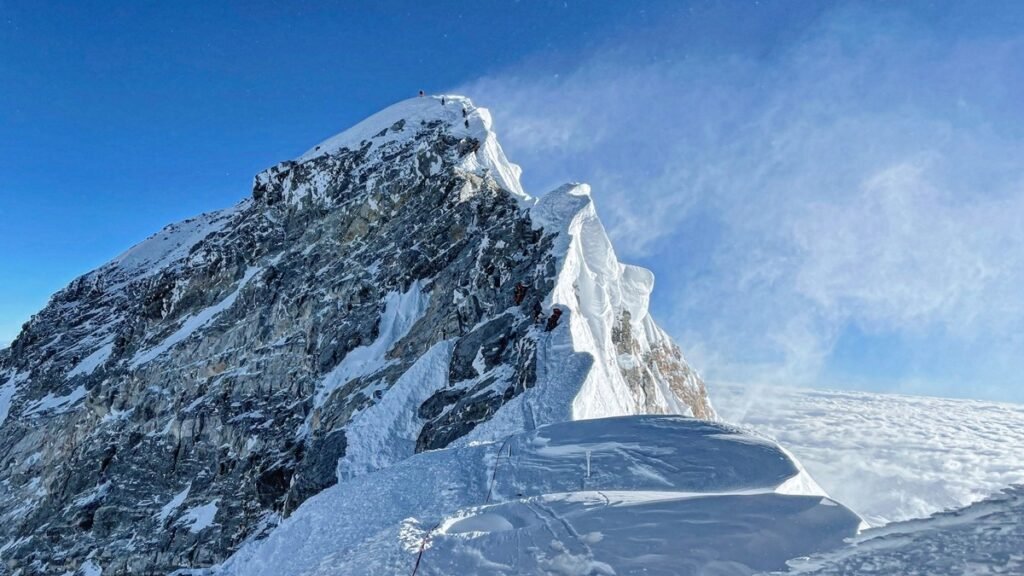Kangchenjunga, the world’s third-highest peak, stands as a powerful beacon of nature, spirituality, and adventure, creating an unforgettable allure for trekkers, locals, and explorers alike. Rising 8,586 meters (28,169 feet), this unique massif anchors the far eastern Himalayas, straddling Nepal and India, and captivating all with its snowy majesty, storied past, and profound cultural significance.
Location and Geography
Kangchenjunga crowns the eastern Himalayas, situated along the border between Nepal’s Taplejung District and the Indian state of Sikkim. It lies about 74 km north-northwest of Darjeeling, with five prominent summits forming a cross-shaped massif: Kangchenjunga Main, Yalung Kang, Kangchenjunga Central, Kangchenjunga South, and Kangbachen. Its ridges act as vital watersheds channelling glacial melt into major rivers like the Teesta, Arun, and Kosi, which sustain millions downstream.
Height and Structure
As the highest point in India and the third-highest worldwide (after Everest and K2), Kangchenjunga rises to 8,586 meters above sea level. Its complex mix of cross-shaped ridges, towering glaciers, and steep faces, forged by tectonic forces and metamorphic rock, makes it both a geographical wonder and a technical climbing challenge. The sheer altitude causes drastic temperature changes, ranging from 15 °C to 25 °C in lower areas to -30 °C at the summit.
Key Details:
Additional Notes:
- The region is less crowded than other major Nepalese treks, making it ideal for adventure seekers who want to experience untouched Himalayan scenery.
- Always check for the latest travel and conservation rules before planning your journey, as national park regulations and access can change due to ecology or political situations.
Historical Significance and Exploration
The name “Kangchenjunga” translates as “The Five Treasuries of the Great Snow,” referencing the five sacred peaks believed to house spiritual and earthly treasures. Its mythic status long predates Western exploration, with indigenous Lepcha and Bhutia communities revering the mountain as the guardian deity Kangchendzonga.
British surveyor Joseph Dalton Hooker mapped the region in the mid-1800s, followed by pioneering but tragic climbing attempts. The first successful ascent was celebrated in 1955 by Joe Brown and George Band, whose respectful summit traditions honour local customs by never standing atop the peak.
Cultural Importance
Kangchenjunga’s influence permeates local culture and faith. For communities in Sikkim and eastern Nepal, the mountain represents protection, prosperity, and spiritual harmony. Expeditions are strictly banned from the Sikkim side, reflecting deep respect and the legal safeguarding of sacred status. Its slopes cradle the homes and monasteries of diverse ethnic groups, Lepcha, Bhutia, Sherpa, Tamang, Rai, and Limbu, each with unique festivals, legends, and rituals rooted in reverence for the mountain.
Conservation and Wildlife
To sustain this delicate ecosystem, large swathes of Kangchenjunga are protected under the Kangchenjunga Conservation Area (Nepal) and Khangchendzonga National Park (India/UNESCO World Heritage site). The region shelters elusive wildlife, including snow leopards, red pandas, Himalayan black bears, and a diverse array of rare alpine plants. Ongoing conservation efforts counter the threats posed by climate change, glacial retreat, and tourism.
Climate and Environmental Influence
Life around Kangchenjunga is shaped by extremes, intense cold, monsoon rains, and rapid climate shifts. Its dramatic elevation creates distinct microclimates:
- Lower valleys are lush and temperate (15–25°C)
- Mid-altitudes are cool (5–15°C), supporting villages and forests
- High camps endure freezing cold (-5°C to -30°C), snow, and wind.
Global warming has accelerated the melting of glaciers, a crisis underscored by recent “black and snow-less” views of the peak, sparking fears of future water shortages and unstable hydropower supplies for Sikkim and northeastern India.
Popular Trekking Routes
Kangchenjunga is a favourite among intrepid trekkers seeking solitude and pristine Himalayan wilderness. The region offers three celebrated trekking options:
Travellers must secure permits and a licensed guide, as the region is classified as “restricted” for environmental and cultural preservation. Treks feature dramatic altitude changes, basic lodges, and interactions with the Sherpa, Rai, and Limbu communities.
Adventure and Mountaineering
Kangchenjunga attracts only the most experienced mountaineers. Its remote location, technical ridges, unpredictable weather, and respect for local customs make it one of the least climbed 8,000-meter peaks. Notable climbers continue to attempt new routes and summits, often reporting both awe and humility in the face of the mountain’s challenges.

Tourist Spots and Activities
In addition to trekking and climbing, visitors delight in:
- Exploring villages like Ghunsa and Taplejung for cultural immersion
- Visiting Buddhist monasteries and sacred sites for spiritual reflection
- Birdwatching and nature photography, especially the famous sunrise views from Singalila Ridge and Sandakphu
- Sampling local cuisine and traditional crafts
Tourism is carefully controlled to strike a balance between adventure and regional sustainability.
Recent News: Climate and Conservation
In May 2025, images of a bare Kangchenjunga provoked urgent discussions about the impacts of climate change on Himalayan water resources, local agriculture, and community livelihoods. The rapidly vanishing snow cover, unpredictable weather, and increased glacial retreat underscore the mountain’s vulnerability and the need for stronger global conservation action.
Meanwhile, local leaders and spiritual groups in Sikkim protested a military expedition to the sacred peak, underscoring deep-rooted cultural and legal protections for Kangchenjunga’s spiritual sanctity.
Characteristic Features
- Cross-shaped massif with five distinct peaks
- Four key glaciers (Zemu, Talung, Yalung, Kangchenjunga) feed major river systems
- Rich biodiversity, snow leopards, red pandas, rare rhododendrons
- Profound mythological and spiritual resonance
FAQs About Kangchenjunga
Why is Kangchenjunga considered sacred?
Kangchenjunga is viewed as the guardian deity by the Lepcha and Bhutia people, symbolising protection, prosperity, and spiritual significance.
What is its height, and where is it located?
It rises to 8,586 meters (28,169 feet), situated on the Nepal-Sikkim border in the eastern Himalayas.
Can one climb Kangchenjunga from Sikkim?
No, climbs from the Sikkim side are banned due to cultural respect and local law; expeditions take place only from Nepal.
What are the popular trekking routes?
The North Base Camp Trek (Pangpema), South Base Camp Trek (Oktang), and the full Circuit Trek are the most popular options, ranging from 15 to 25 days.
How is climate change affecting Kangchenjunga?
Warming temperatures have led to rapid glacial retreat and reduced snow cover, posing a threat to water security and local habitats.
Which fauna can be seen around Kangchenjunga?
The area is home to snow leopards, red pandas, Himalayan black bears, and rare birds, especially within conservation zones.
What permits and preparations are required for trekking?
A restricted area permit, TIMS card, and licensed guide are mandatory; treks require significant physical fitness and acclimatisation.
What cultural experiences await trekkers?
Travellers encounter vibrant ethnic communities, ancient monasteries, mountain festivals, local crafts, and traditional foods.
